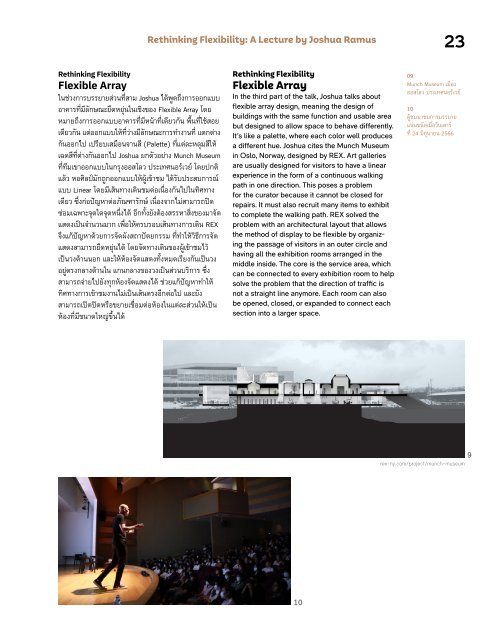ASA JOURNAL 14/2023
You also want an ePaper? Increase the reach of your titles
YUMPU automatically turns print PDFs into web optimized ePapers that Google loves.
Rethinking Flexibility: A Lecture by Joshua Ramus<br />
23<br />
Rethinking Flexibility<br />
Flexible Array<br />
ในช่วงการบรรยายส่วนที่สาม Joshua ได้พูดถึงการออกแบบ<br />
อาคารที่มีลักษณะยืดหยุ่นในเชิงของ Flexible Array โดย<br />
หมายถึงการออกแบบอาคารที่มีหน้าที่เดียวกัน พื้นที่ใช้สอย<br />
เดียวกัน แต่ออกแบบให้ที่ว่างมีลักษณะการทำ างานที่ แตกต่าง<br />
กันออกไป เปรียบเสมือนจานสี (Palette) ที่แต่ละหลุมสีให้<br />
เฉดสีที่ต่างกันออกไป Joshua ยกตัวอย่าง Munch Museum<br />
ที่ทีมเขาออกแบบในกรุงออสโลว ประเทศนอร์เวย์ โดยปกติ<br />
แล้ว หอศิลป์มักถูกออกแบบให้ผู้เข้าชม ได้รับประสบการณ์<br />
แบบ Linear โดยมีเส้นทางเดินชมต่อเนื่องกันไปในทิศทาง<br />
เดียว ซึ่งก่อปัญหาต่อภัณฑารักษ์ เนื่องจากไม่สามารถปิด<br />
ซ่อมเฉพาะจุดใดจุดหนึ่งได้ อีกทั้งยังต้องสรรหาสิ่งของมาจัด<br />
แสดงเป็นจำานวนมาก เพื่อให้ครบรอบเส้นทางการเดิน REX<br />
จึงแก้ปัญหาด้วยการจัดผังสถาปัตยกรรม ที่ทำาให้วิธีการจัด<br />
แสดงสามารถยืดหยุ่นได้ โดยจัดทางเดินของผู้เข้าชมไว้<br />
เป็นวงด้านนอก และให้ห้องจัดแสดงทั้งหมดเรียงกันเป็นวง<br />
อยู่ตรงกลางด้านใน แกนกลางของวงเป็นส่วนบริการ ซึ่ง<br />
สามารถจ่ายไปยังทุกห้องจัดแสดงได้ ช่วยแก้ปัญหาทำาให้<br />
ทิศทางการเข้าชมงานไม่เป็นเส้นตรงอีกต่อไป และยัง<br />
สามารถเปิดปิดหรือขยายเชื่อมต่อห้องในแต่ละส่วนให้เป็น<br />
ห้องที่มีขนาดใหญ่ขึ้นได้<br />
Rethinking Flexibility<br />
Flexible Array<br />
In the third part of the talk, Joshua talks about<br />
flexible array design, meaning the design of<br />
buildings with the same function and usable area<br />
but designed to allow space to behave differently.<br />
It’s like a palette, where each color well produces<br />
a different hue. Joshua cites the Munch Museum<br />
in Oslo, Norway, designed by REX. Art galleries<br />
are usually designed for visitors to have a linear<br />
experience in the form of a continuous walking<br />
path in one direction. This poses a problem<br />
for the curator because it cannot be closed for<br />
repairs. It must also recruit many items to exhibit<br />
to complete the walking path. REX solved the<br />
problem with an architectural layout that allows<br />
the method of display to be flexible by organizing<br />
the passage of visitors in an outer circle and<br />
having all the exhibition rooms arranged in the<br />
middle inside. The core is the service area, which<br />
can be connected to every exhibition room to help<br />
solve the problem that the direction of traffic is<br />
not a straight line anymore. Each room can also<br />
be opened, closed, or expanded to connect each<br />
section into a larger space.<br />
09<br />
Munch Museum เมือง<br />
ออสโลว ประเทศนอร์เวย์<br />
10<br />
ผู้ชมมาชมการบรรยาย<br />
แน่นขนัดเมื่อวันเสาร์<br />
ที่ 24 มิถุนายน 2566<br />
rex-ny.com/project/munch-museum<br />
9<br />
10


















